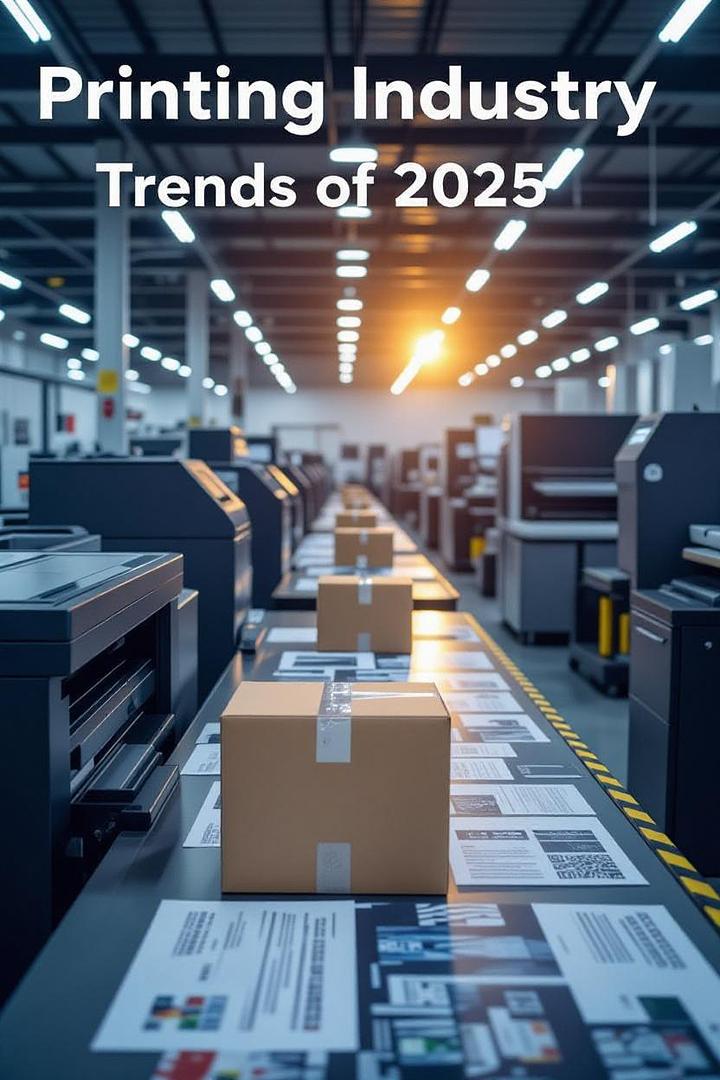Menu
 Printing Trends in 2025: Innovation, Sustainability, and Personalization
Printing Trends in 2025: Innovation, Sustainability, and Personalization
The printing industry is undergoing an unprecedented transformation, driven by technological innovation, increasing demand for sustainability, and the need to adapt to an ever-evolving market. In 2025, emerging trends are reshaping how businesses in the sector operate, meeting the demands of clients who prioritize quality, speed, and customized solutions. Here’s an overview of the key trends shaping the future of printing.
1. Digitalization and Automation: The Printing 4.0 Revolution
Digital printing continues to dominate the landscape due to its flexibility and ability to deliver short runs and personalized outputs with reduced production times. Technologies such as high-speed inkjet printing and integrated management systems are revolutionizing production processes. The latest machines, showcased at international trade shows like Drupa, incorporate artificial intelligence (AI) and advanced automation to optimize workflows, minimize errors, and enhance efficiency.
For instance, cloud-connected printing solutions enable real-time monitoring of machine performance, predictive maintenance, and seamless customization of projects through digital platforms. This approach, known as “Printing 4.0,” allows businesses to respond quickly to client demands while maintaining high-quality standards.
2. Sustainability: A Must for the Future
Sustainability is at the core of printing companies’ strategies in 2025. Consumers and environmental regulations are pushing for more responsible practices, such as the use of eco-friendly water-based or vegetable-based inks, FSC (Forest Stewardship Council) certified paper, and low-energy production processes.
LED UV printing technologies, for example, are gaining traction for their ability to reduce energy consumption compared to traditional methods. Additionally, manufacturers are investing in solutions for recycling production waste and designing machines that minimize material waste. Companies adopting these practices not only meet client expectations but also position themselves as leaders in an increasingly eco-conscious market.
3. Mass Personalization: The Rise of On-Demand Printing
The demand for personalized printed products is surging, particularly in the packaging, publishing, and marketing sectors. On-demand printing enables the creation of tailored products, such as customized packaging or limited-edition books, without the high costs of traditional mass production.
In 2025, digital printing technologies allow for unique designs with variable data, catering to each client’s specific needs. For example, packaging companies are leveraging digital printing to offer bespoke boxes for luxury brands or limited editions, enhancing the perceived value of the product.
4. Smart and Functional Packaging
The packaging sector is experiencing significant evolution, with a focus on “smart” and functional solutions. Printing packaging with QR codes, RFID tags, or interactive inks allows consumers to access additional information, such as product traceability or exclusive digital content.
Moreover, advanced printing machines, such as next-generation folder-gluers, offer greater precision and speed, meeting the growing demand for sustainable and customized packaging in industries like pharmaceuticals, food, and cosmetics.
5. Integration with Augmented Reality
Augmented reality (AR) is transforming how printed materials interact with consumers. In 2025, companies are integrating printed elements with AR applications to create immersive experiences. For example, a printed catalog can include scannable codes that, via an app, display videos, animations, or 3D product previews.
This trend is particularly relevant in marketing, where printed materials serve as a bridge between the physical and digital worlds, boosting customer engagement.
6. Challenges and Opportunities: Competitiveness and Innovation
Despite the opportunities these trends present, the printing industry faces challenges such as price pressure and the need to invest in cutting-edge technologies. Companies that stand out are those that combine technological innovation with a client-centric approach, offering tailored solutions and maintaining high-quality standards.
Partnerships with leading printing machine manufacturers, such as those recently showcased by Indian and European producers, are helping businesses stay competitive. Machines like flatbed die-cutters or automated folder-gluers enable cost optimization and improved productivity.
Conclusion: Looking to the Future with Optimism
The year 2025 marks a pivotal moment for the printing industry, with innovations redefining its paradigms. From digitalization to sustainability, from personalization to integration with technologies like augmented reality, companies that embrace these trends will thrive in a constantly evolving market.
If you’re a printing professional, now is the time to explore new technologies and partner with reliable suppliers to elevate your business. The future of printing is here, and it promises to be more dynamic than ever.
#PrintingTrends #DigitalPrinting #Sustainability #Print4_0 #OnDemandPrinting #SmartPackaging #AugmentedReality #PrintingInnovation #EcoFriendlyPrinting #PackagingTrends
